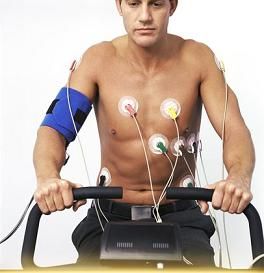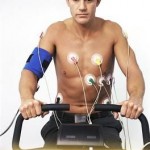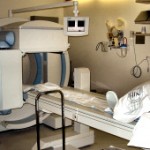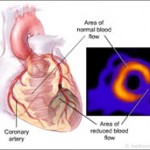Adenosine thallium scan: A method of examining the heart to obtain information about the blood supply to the heart muscle. Special cameras take a series of pictures of the heart. Radioactive thallium is injected into the bloodstream and serves as a tracer. The tracer attaches to certain cells and makes them visible to the special camera. The tracer attaches to the muscle cells of the heart so the imaging camera can take pictures of the heart muscles. If an area of the heart does not receive an adequate flow of blood, the cells in the underserved area do not receive as much tracer and it appears as a darker area on the picture taken by the camera.
There are two parts to the adenosine thallium scan: the medication portion with pictures, and the rest portion with pictures. In lieu of exercise on a treadmill, the medication adenosine is given IV to exercise the heart.
The patient has an IV (intravenous) line placed in the arm, EKG patches will be applied to chest and connected to an EKG machine to monitor the heart and a blood pressure cuff will be placed on the arm to monitor blood pressure. The patient lies on a table and the medication, adenosine, will be given through the IV. The heart pumps faster and more strongly. The tracer is then given through the IV. This part of the scan lasts about 25 minutes.
A second set of pictures is taken approximately 3 hours after the injection. The patient should not eat but can drink fluids that do not contain caffeine. The entire test takes approximately 5 to 6 hours.
To prepare for the scan, the patient should not drink or eat anything containing caffeine for 24 hours before the test (this includes decaf coffee and chocolate) and should not eat or drink after midnight and not smoke on the day of the test. Most medications are taken as usual; however, some medications (e.g., theophylline, Persantine, and trental) can interfere with the adenosine scan. One should seek special instructions from the doctor or nurse, as should all diabetics.
The amount of radiation from the scan is no more than from other x-ray tests. If there is any chance a woman might be pregnant, she should notify the doctor or nurse before the test is done. If a patient has asthma or other lung problems, he or she should also notify the doctor or nurse before the test is done. A medicine other than adenosine may be recommended.
Examples of possible nuclear stress test results:
- If the scan is normal during both exercise and rest, then blood flow through the coronary arteries is most likely normal as well. No significant coronary artery blockage is suspected.
- If the scan is normal at rest but abnormal following exercise (a reversible perfusion defect), then the heart isn’t receiving enough blood when it’s under stress. This may be due to blockage in one or multiple coronary arteries.
- If abnormal blood flow is detected both at rest and with stress, this suggests that part of the heart has suffered injury in the past. This is often the case following a heart attack.
What is the reliability of a Chemical Isotope Stress Test?
If a patient is able to achieve the target heart rate in cases of dobutamine or an appropriate drop in the diastolic blood pressure with dipyridamole, and if good quality images are obtained, an isotope treadmill stress test is capable of diagnosing important disease in approximately 80% of patients with coronary artery disease. Approximately 10% of patients may have a “false-positive” test (when the results are falsely abnormal in a patient without coronary artery disease). Technical problems can occur when a patient is markedly overweight. Women may have an abnormality in the front portion of the heart because of overlying breast tissue. Some men may demonstrate an inferior wall abnormality because of a prominent diaphragm (muscular partition that separates the chest cavity from the abdomen. Patients who have a left bundle branch block on their EKG may also have a false abnormal test.
COMMONLY ASKED QUESTIONS
Q. Why can’t I eat or drink before the test?
A. Imaging drugs travel to any working muscle. When you eat or drink, your stomach becomes a working muscle and would be working as hard as your heart. This would make the test results difficult to interpret, possibly resulting in false readings or having to reschedule the test another time.
Q. What if I don’t feel good the day before the test or the day of the test?
A. Please consult your doctor if you are not feeling well. If you need to reschedule your test contact your doctor as soon as possible.
Q. How will I feel during the test?
A. During the test you may feel some side effects from the drug, Adenosine. Some people do not experience any side effects. You may experience the following:
- Heavier breathing
- Chest pain
- Headache
- Flushing, nausea, or a “funny” feeling



